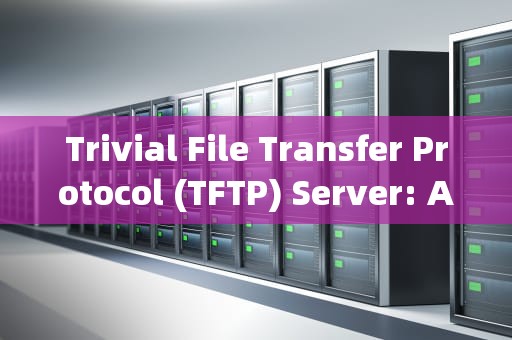In the realm of network services, various protocols are designed to transfer files between computers. One such protocol is the Trivial File Transfer Protocol (TFTP), a simple and lightweight file transfer service that is often overlooked but plays a crucial role in specific scenarios. This article delves into what a TFTP server is, its functionality, use cases, and how it differs from other more complex protocols like FTP (File Transfer Protocol).

What is a TFTP Server?
A TFTP server is a network service that allows for the transfer of files between a client machine and a server using the TFTP protocol. Unlike FTP, which is more feature-rich and complex, TFTP is minimalistic and does not require extensive configuration or resource consumption. It is primarily used for small file transfers within a local network where security is not a significant concern.
Key Features of TFTP Server
1、Simplicity: TFTP is designed to be as simple as possible. It lacks many features found in FTP, such as user authentication, directory listing, or file manipulation commands.
2、Operation Modes: TFTP operates in three modes – Netascii (for text files), Octet (for binary files), and Mail (rarely used). The mode is determined by the client's request.
3、Port Number: By default, TFTP servers listen on UDP port 69. This choice of UDP over TCP makes it unsuitable for reliable transmission but reduces latency and overhead.
4、No Persistent Connection: Each TFTP transaction is stateless; after a file is transferred, the connection is closed immediately. There's no concept of a persistent session like in FTP.
5、Limited Error Handling: Error handling in TFTP is minimal. If an error occurs during transmission, the operation simply fails with a generic error message.
Use Cases for TFTP Servers
Despite its limitations, TFTP has specific applications where its simplicity is an advantage:
1、Firmware Upgrades: Many network devices, such as routers and switches, use TFTP for firmware upgrades due to its lightweight nature and ease of use.
2、Bootloading: Some embedded systems boot from a network location using a TFTP server to load the operating system or application code directly into memory.
3、Configuration Management: Simple configuration files can be distributed across a network using TFTP without the need for complex setup procedures.
4、Testing and Development: Developers might use TFTP for quick file transfers during testing phases when security and advanced features are secondary concerns.
5、Diskless Workstations: In environments where workstations do not have their own storage media, TFTP can be used to load the operating system and applications from a central server.
Differences Between TFTP and FTP
While both TFTP and FTP serve the purpose of transferring files, there are notable differences:
Complexity: FTP is much more complex than TFTP, offering features like user authentication, directories, file permissions, and more. TFTP, on the other hand, focuses solely on file transfer with minimal overhead.
Reliability: FTP uses TCP, which ensures reliable data transfer with error checking and recovery mechanisms. TFTP uses UDP, which is faster but less reliable, making it prone to packet loss and corruption.
Security: FTP supports secure connections via TLS/SSL (FTPS) and SSH (SFTP or SCP), providing encryption and secure authentication. TFTP does not include any security measures, making it unsuitable for unsecured networks or sensitive data transfers.
Use Cases: As mentioned earlier, TFTP is ideal for small, quick transfers within a trusted network, while FTP is better suited for larger file sizes, cross-network transfers, and situations requiring security and robustness.
Conclusion
The TFTP server represents a fundamental yet specialized tool in the network administrator's toolkit. Its simplicity and low resource requirements make it perfect for tasks involving rapid, short-distance file transfers without the need for security or advanced features. However, when dealing with larger files, long-distance transfers, or situations requiring data security, other protocols like FTP or its secure variants should be considered. Understanding the strengths and limitations of TFTP helps IT professionals select the appropriate tool for the job, ensuring efficient and effective network operations.
随着互联网的普及和信息技术的飞速发展台湾vps云服务器邮件,电子邮件已经成为企业和个人日常沟通的重要工具。然而,传统的邮件服务在安全性、稳定性和可扩展性方面存在一定的局限性。为台湾vps云服务器邮件了满足用户对高效、安全、稳定的邮件服务的需求,台湾VPS云服务器邮件服务应运而生。本文将对台湾VPS云服务器邮件服务进行详细介绍,分析其优势和应用案例,并为用户提供如何选择合适的台湾VPS云服务器邮件服务的参考建议。

工作时间:8:00-18:00
电子邮件
1968656499@qq.com
扫码二维码
获取最新动态
